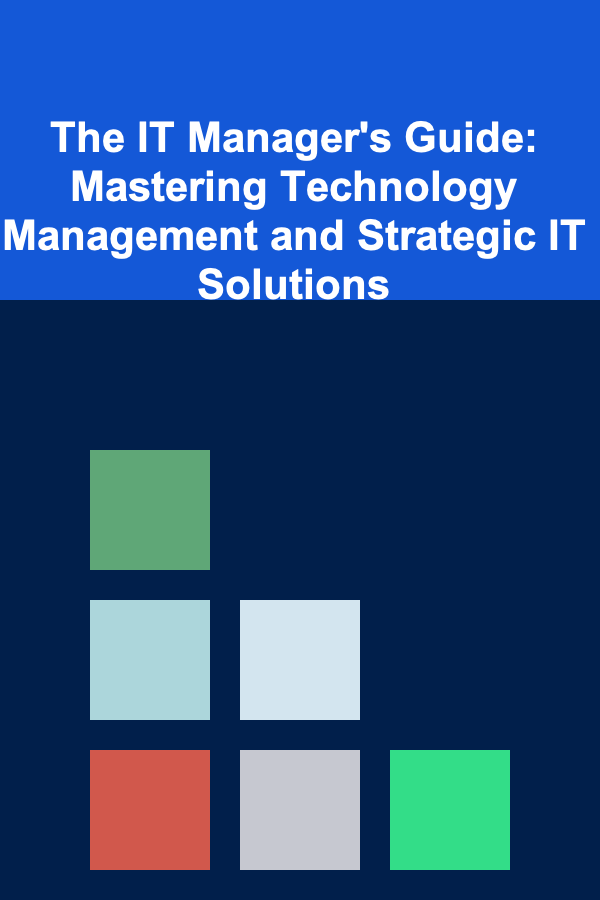
The IT Manager's Guide: Mastering Technology Management and Strategic IT Solutions
ebook include PDF & Audio bundle (Micro Guide)
$12.99$6.99
Limited Time Offer! Order within the next:

In the modern workplace, technology is more than just a tool---it's the backbone of every business. From cloud computing and cybersecurity to data management and system integration, IT managers are at the forefront of ensuring that an organization's technology infrastructure runs efficiently and aligns with strategic business goals. In this guide, we will explore the essential skills, strategies, and best practices for IT managers, providing actionable insights to help you navigate the complex and ever-evolving technology landscape.
Understanding the Role of an IT Manager
The role of an IT manager is multifaceted. Not only do they oversee an organization's IT infrastructure, but they also play a crucial role in aligning technology with business objectives. The job demands a unique blend of technical expertise, leadership skills, and strategic thinking. IT managers are responsible for evaluating and implementing new technologies, ensuring network security, managing IT teams, and providing tech support to employees.
An IT manager's core responsibilities typically include:
- Technology Strategy Development: Crafting a technology strategy that supports the company's overall business goals.
- Infrastructure Management: Overseeing the maintenance and growth of the company's IT infrastructure, including servers, networks, and hardware.
- Budgeting and Resource Allocation: Ensuring that technology investments are aligned with business needs and that resources are effectively allocated.
- Security Management: Protecting sensitive data, maintaining compliance with regulations, and ensuring robust cybersecurity.
- Team Leadership and Development: Managing IT teams, fostering professional development, and ensuring the team stays up to date with technological advancements.
To excel in this role, an IT manager must be proficient not only in technical domains but also in leadership, communication, and business acumen.
Developing a Technology Strategy Aligned with Business Goals
A key part of an IT manager's responsibility is ensuring that the organization's technology aligns with its long-term business strategy. A well-defined technology strategy can improve operational efficiency, foster innovation, and enhance the company's competitive advantage.
Actionable Tips for Developing a Technology Strategy
- Understand Business Objectives: Before implementing any technology solutions, IT managers need to have a clear understanding of the company's business objectives. This requires close collaboration with leadership and other departments to ensure that IT initiatives directly support company goals.
- Assess Current IT Infrastructure: Conduct a thorough assessment of the current IT environment to identify gaps and opportunities for improvement. This includes evaluating hardware, software, security systems, and network performance.
- Future-Proof Technology: Anticipate future technology trends and plan for scalability. As businesses grow, their technology needs will evolve, and it's important to choose solutions that can accommodate future demands.
- Invest in Innovation: Look for emerging technologies such as artificial intelligence (AI), machine learning, and cloud computing that can drive business transformation. Staying ahead of the technology curve helps the company gain a competitive edge.
Example: A company might invest in a cloud-based ERP (Enterprise Resource Planning) system to streamline its operations and reduce costs. By aligning this decision with broader business goals such as increasing efficiency and supporting remote work, the IT manager helps drive overall organizational growth.
Mastering IT Infrastructure Management
Efficient IT infrastructure management is at the heart of an IT manager's responsibilities. A reliable infrastructure ensures that technology runs smoothly, which in turn keeps the business operations running without interruption.
Actionable Tips for Managing IT Infrastructure
- Regular Monitoring and Maintenance: Proactively monitor systems to detect and address any performance issues before they escalate. Regular maintenance schedules for servers, workstations, and networking equipment should be established to minimize downtime.
- Virtualization and Cloud Solutions: Embrace cloud computing and virtualization to improve scalability, flexibility, and cost-efficiency. Cloud-based services allow businesses to scale IT resources up or down based on demand without heavy upfront investments in physical infrastructure.
- Disaster Recovery Planning: Ensure that there is a robust disaster recovery plan in place. This includes regular backups, offsite data storage, and a plan for how to restore critical systems in case of a failure.
- Automation: Implement automation tools to streamline routine tasks such as software updates, network monitoring, and data backups. This reduces the manual workload for IT teams and minimizes human error.
Example: By transitioning to a cloud-based infrastructure, a company can reduce the burden of managing on-premises servers, while increasing uptime and accessibility for employees working remotely.
Cybersecurity: Protecting the Organization's Data
Cybersecurity is one of the most critical concerns for IT managers. With cyber threats becoming increasingly sophisticated, it's essential to develop a proactive security strategy that safeguards sensitive data and protects the organization from data breaches, ransomware attacks, and other threats.
Actionable Tips for Enhancing Cybersecurity
- Risk Assessment and Threat Detection: Conduct regular risk assessments to identify potential vulnerabilities in the system. Implement tools for real-time threat detection and continuous monitoring of networks and endpoints.
- Data Encryption: Ensure that sensitive data is encrypted both in transit and at rest. Encryption protects data from unauthorized access and is a fundamental component of cybersecurity.
- Employee Training: Provide ongoing cybersecurity training to employees, teaching them about phishing attacks, password management, and safe browsing habits. Often, the weakest link in security is human error.
- Security Policies and Compliance: Develop and enforce IT security policies, ensuring that the organization adheres to industry standards and regulatory requirements (e.g., GDPR, HIPAA, etc.).
- Incident Response Plan: Prepare an incident response plan to act quickly in case of a breach. This plan should detail how to contain the breach, notify affected parties, and investigate the cause.
Example: Implementing multi-factor authentication (MFA) for all company systems can significantly reduce the risk of unauthorized access, especially for critical systems such as email, cloud platforms, and financial data.
Optimizing IT Budgets and Resource Allocation
IT managers must be skilled in managing budgets and allocating resources effectively. Technology investments are often significant, so it's important to ensure that every expenditure provides value and supports business objectives.
Actionable Tips for Budgeting and Resource Allocation
- Forecast IT Costs: Develop an accurate forecast of future IT costs, including hardware, software, licensing, staffing, and training. This helps ensure that the company can meet its technological needs without overspending.
- Prioritize Critical Investments: Identify critical IT initiatives that will have the highest impact on the business. For example, investing in cybersecurity or upgrading the network infrastructure might take precedence over less urgent expenses.
- Leverage Vendor Relationships: Establish strong relationships with technology vendors to negotiate favorable pricing and service-level agreements. Consider volume discounts and explore options for leasing or renting expensive equipment.
- Cost-Benefit Analysis: Before making any major technology investment, conduct a thorough cost-benefit analysis. Compare the long-term benefits of the technology with the upfront and ongoing costs to ensure that it delivers measurable value.
Example: An IT manager might decide to invest in a robust cloud storage solution after comparing the costs of maintaining on-premises hardware, the need for scalability, and the expected improvement in productivity.
Leading and Developing IT Teams
An IT manager's success is closely tied to the performance of their team. Effective leadership involves not only overseeing day-to-day operations but also fostering professional development and ensuring that team members have the skills to handle the evolving demands of technology.
Actionable Tips for Effective Team Leadership
- Clear Communication: Maintain open lines of communication with your IT team. Be transparent about expectations, project timelines, and organizational goals to foster a collaborative environment.
- Continuous Learning: Encourage ongoing education and certification for team members. Technology is constantly evolving, so it's important that the team stays updated with new trends, tools, and best practices.
- Delegate Effectively: Delegate tasks according to each team member's strengths and expertise. Empowering your team to take ownership of specific projects or areas of responsibility helps develop their skills and fosters accountability.
- Performance Reviews and Feedback: Regularly conduct performance reviews to provide constructive feedback and recognize accomplishments. A motivated team is more likely to be productive and engaged.
Example: Offering training on emerging technologies like cloud computing or DevOps can help the IT team stay competitive and bring innovative solutions to the organization.
Conclusion
As the technological landscape continues to evolve, IT managers must be prepared to navigate new challenges and seize opportunities for improvement. By mastering the fundamentals of technology strategy, infrastructure management, cybersecurity, budgeting, and team leadership, IT managers can play a critical role in driving the success of their organizations. Building a strategic vision that aligns with business goals, investing in cutting-edge technologies, and fostering a culture of continuous learning are all essential for staying ahead in today's dynamic IT environment.
The role of an IT manager is no longer limited to maintaining systems; it's about strategically leveraging technology to drive innovation, improve efficiency, and support business growth.
Reading More From Our Other Websites
- [Survival Kit 101] How to Stock Up on Essential Emergency Supplies for Your Family
- [Trail Running Tip 101] Best Trail‑Running Hydration Solutions for Sub‑Zero Conditions
- [Personal Care Tips 101] How to Stay Active with a Busy Family Life
- [Home Party Planning 101] How to Organize a Potluck Party with Minimal Effort
- [Organization Tip 101] Budget-Friendly Sensory Room Ideas for Every Home
- [Personal Care Tips 101] How to Use Hand Cream for Anti-Aging Benefits
- [Home Space Saving 101] How to Conquer Clutter with Smart Small Bathroom Storage Solutions You Haven't Considered
- [Organization Tip 101] How to Maintain an Inventory of Laundry Supplies
- [Organization Tip 101] How to Sort and Store Hair Care Products Effectively
- [Small Business 101] Startup Business: Top Mistakes to Avoid During Your First Year

How to Make a Checklist for Year-End Tax Preparation
Read More
How to Renovate Your Home with Vintage or Antique Elements
Read More
How To Understand Data Encryption for Everyday Privacy
Read More
How To Interpret Pharmacogenomic Test Results
Read More
How to Automate Repetitive Tasks
Read More
How to Plan a Wine Tasting Party on a Budget
Read MoreOther Products

How to Make a Checklist for Year-End Tax Preparation
Read More
How to Renovate Your Home with Vintage or Antique Elements
Read More
How To Understand Data Encryption for Everyday Privacy
Read More
How To Interpret Pharmacogenomic Test Results
Read More
How to Automate Repetitive Tasks
Read More